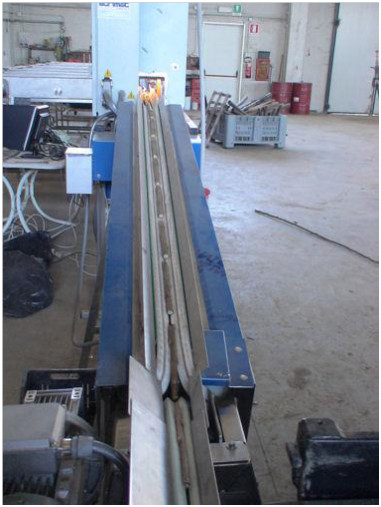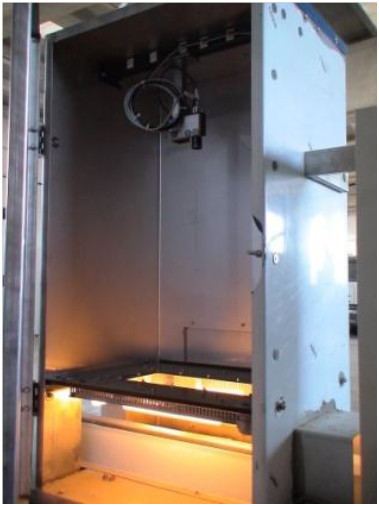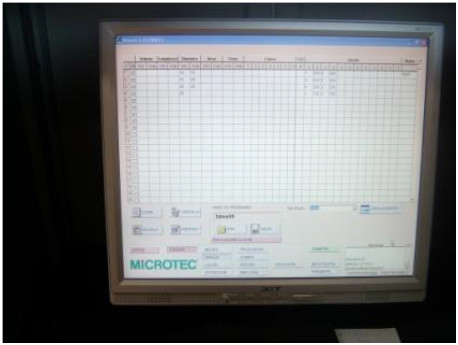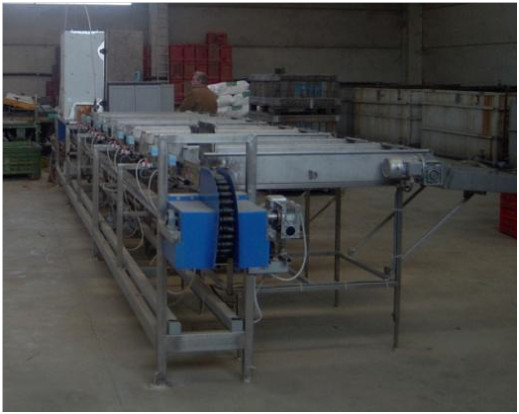The bio-energy market is still growing and, in the coming years, is expected to significantly increase the short rotation forestry (SRF) poplar plantings due to the biomass demand from energy conversion plants. In order to reduce the cost of planting SRF poplars (around € 2000 per ha), The Panacea group has promoted a research aimed to differentiating poplar cuttings according to their diameter before putting them into bags, which is essential for the automation of transplanting. Moreover, in 2009, the cost of planting, for the most part, was due to purchasing cuttings at € 0.22 a piece. The high costs were usually due to the lack of adequate machinery for harvesting the 1 year old plants and for producing subsequent cuttings.
During production, the selection and packaging of cuttings presents several problems: the one year old plants belonged to different clones and therefore had different sizes (basal diameter between 15 mm and 30 mm, height between 1.5 m and 4 m); the one year old plants had a conical shape, hence basal cuttings had a greater diameter with respect to the apical ones. The one year old plants were brought to the cutting production centre in bundles and single plants were then manually put on the cutter equipment. The plants were segmented by a machine that had circular blades positioned at 215 mm, which produced pieces of plant of the same length but with different diameters. Today, the downstream measurement of the segmentation is manual, causing a great deal of manpower and a lack of uniformity in the results. Measuring the cuttings as precisely as possible in diameter classes was necessary in order to ensure the development of an automatic feeding system for the transplanter. Preserving the germination of the bud by avoiding abrasions and contusions, as well maintaining the polarity of the cuttings, is also necessary to correctly position the cuttings into the soil.
In order to find solutions compatible with the problems described above, Panacea group, in collaboration with the Agrimat company of Tortona (AL), Franco Alasia Vivai in Savignano (AL) and with the support from Enama, has developed a machine for optically selection of cuttings according to their diameter by a calibration machine commonly used for the selection of asparagus. In this study, the first results of the tests carried out by CRA-ING that evaluated the performance of the prototype are reported. The work identifies problems and suggests appropriate adjustments.
The machine had the following basic components: a V-shaped conveyor belt of 500 cm, which took poplar cuttings as they come out after being cut from the cutter device (at 215 mm cut); and a V-shaped conveyor belt of 200 cm (variable speed), which aligned and distanced the cuttings about 4-5 cm apart. The second tape was needed because the one year old plants were cut by circular blades of 2 mm in thickness. This configuration resulted in the cuttings falling close to one another into the V-shaped conveyor belt, which could have lead to some reading problems by the optical system. For this reason, the second conveyor belt proceeded at a faster speed in respect to the first one, thus separating adjacent cuttings.
An optical electronic device was used to read the diameter. The cuttings were transported by biconic rollers, which served to focus the product under a camera for reading. As mentioned before, the principle idea was partly borrowed from the selection of asparagus shoots.
 |
 |
|
The V-shaped conveyor belt |
Optical system calibration |
A pneumatic system was managed by a software that permit by a whiff of air to direct the cuttings towards the specific output. The nozzles under the signal of an electro-pneumatic valve sent the air. Cuttings were directed to specific outputs once they were identified by the optical system. Four outputs (A, B, C, D), that alternately unloaded into two vessel (A 1-2, B 3-4, C 5-6, D 7-8). The alternation was a good way of giving a single operator in charge of the manual filling of bags the ability to perform this operation on all four size classes. Cuttings lower in diameter than 5 mm felt down from V-shaped conveyor belt, while those lower than the minimum diameter set by the software or those not recognized fell into a gatherer.
 Panacea has tested the machine by surveying the operating parameters in order to evaluate the performance of the current prototype. The test was carried out by using one year old plants of AF2 clone, which had an average height of about 2.5 m and baseline average diameter equal to 3 cm. Each one year old plants on average produced 12 cuttings (including those oversized). The calibration machine worked with an operational capacity of 6.240 cuttings/h (number of cuttings that were calibrated by the optical system).
Panacea has tested the machine by surveying the operating parameters in order to evaluate the performance of the current prototype. The test was carried out by using one year old plants of AF2 clone, which had an average height of about 2.5 m and baseline average diameter equal to 3 cm. Each one year old plants on average produced 12 cuttings (including those oversized). The calibration machine worked with an operational capacity of 6.240 cuttings/h (number of cuttings that were calibrated by the optical system).
The operation of the machine, by setting the software, consisted of a cutting selection of four classes that sent a number of different cuttings to their respective outputs as shown in te following table.
Size classes of cuttings
|
Exit (vessel) |
Diameter |
n. max cuttings per vessel |
|
A (1 – 2) |
> 25 |
150 |
|
B (3 – 4) |
20-25 |
250 |
|
C (5 – 6) |
15-20 |
400 |
|
D (7 – 8) |
10-15 |
600 |
|
Oversize |
6-10 |
Unmeasured |
|
Oversize |
< 6 |
Unmeasured |
For exemple, 150 cuttings of a diameter that exceeded 25 mm were first sent to tank A1, at the exit A, and once they reached the maximum set capacity, they were sent to tank A2. In order to make the bags the same in regards to volume, the number of cuttings had to be set to a lower quantity when the diameter class increases.
The following table summarizes the results. The software surveyed and counted, as valid, only those pieces that were fit to be used as cuttings, as thought by the manufacturer.
The 3,6% of total cuttings, even if they were recognised in diameter and counted, were not be directed by the pneumatic system to the proper exit, fall down on the floor or in the final gatherer.
The 2.2% of cuttings (recognised and counted) gone to the right exit but not in the right vessel (for instance, in vessel A2 instead A1). This means a variability of 3.6% (average of 3.6±2.2) of the number of cuttings per bag. Anyway this error, even if can become better, is acceptable in the estimation of the number of bags have to be used per hectare.
Results of the proof
|
Exit (vessels) |
Diameter (mm) |
% cuttings identified by software |
% pieces hand counted |
% software error |
% lost cuttings |
|
A (1 -2) |
> 25 |
0,8 |
0,6 |
0,0 |
0,0 |
|
B (3-4) |
20-25 |
6,3 |
5,1 |
0,0 |
0,2 |
|
C (5-6) |
15-20 |
39,9 |
31,2 |
1,4 |
2,0 |
|
D (7-8) |
10-15 |
53,0 |
41,2 |
2,2 |
0,0 |
|
Total cuttings |
|
100,0 |
78,1 |
3,6 |
2,2 |
|
Not in size at the end |
|
0,0 |
19,3 |
|
|
|
Not in size at V-belt |
|
0,0 |
2,6 |
|
|
|
Total not in size |
|
|
21,9 |
|
|
In the calibration step, no errors resulted: the optical system clearly identified the diameter of the cuttings. Cleaning was seriously taken into account. Also, for the polarity of cuttings, no errors resulted. On the contrary, the feeding system of the machine for optically selecting cuttings not resulted so efficient. As the cutter device in use today did not show a good performance, a one year old plants cutting system based on counter rotating knives, that is enable to uniform supply all cuttings, is in the planning stages.
The prototype is really interesting, especially for reducing the production costs compared to manual labour, even if it will be improved in order to ensure adaptability and better performance. The correct classification of cuttings according to diameter and compliance of their polarity represents the necessary conditions for the subsequent automated feeding of the transplanter. This phase, which Panacea is working on, will allow a further reduction of manual labour, from 3 to only 1 operator.
